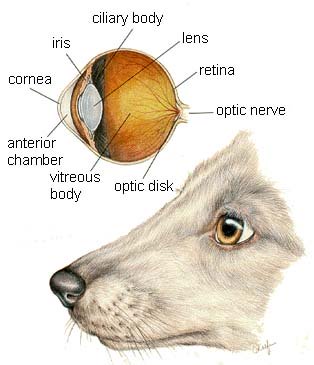Eye: Ulcer
Dog Ear QuickLinks
Causes:
In dogs, dog eye ulcers or corneal ulcer cases are reported to be caused by some mechanical reason. This can be nail injuries, scratches, foreign objects (debris, eyelashes), chemicals etc. which cause a discontinuity of epithelial tissues over the surface of the cornea. This discontinuity of epithelial tissues is simply referred to as an ulceration of the eye. A canine eye ulcer is a slow healing sore since the Corneal surface has no blood vessels, only nerve cells.

Diagram Dog Eye Anatomy
This picture is reprinted with permission by
the copyright owner, Hill's Pet Nutrition, from the
Atlas of Veterinary Clinical Anatomy. These illustrations should not be
downloaded, printed or copied except for personal, non-commercial use.
Anatomically, to have a dog cornea function properly, its surface should be free of any opacity, meaning that it should be truly transparent. Superficial epithelial tissues of the cornea not only act as a protective coating, but also ensures that light enters into the eye without any hindrances. Once this surface is scratched, injured or cellular continuity is disturbed, inflammation may occur. This discontinuity can spread to deeper tissues causing a hole in the cornea, which is referred to as a dog eye ulcer. Secondary infections can worsen the condition, and if the condition is not treated in a timely fashion, permanent loss of eye function, i.e. blindness may occur.
Symptoms:
Typical initial symptoms include excessive tearing, irritation and swelling along with redness of the eye. Some specific symptoms, such as an increase in the frequency of blinking and severe dog eye pain may indicate the presence of a canine eye ulcer.
Since the surface of the cornea has a rich nerve supply, pain is usually felt from a reflex action to the ulcer, but also due to any inflammatory response.
Clinically, a canine eye ulcer is identified by excessive dog eye blinking, pain, irregularity of the cornea and the development of blood vessels on the surface of the cornea. In advanced cases, a hole through the full-thickness of the dog cornea along with bacterial infections are noted.
The presence of a whitish layer of white blood cells and other inflammatory content at the margin of the cornea indicates that there is a secondary infection which needs to be treated immediately.
Diagnosis:
Clinical observation and examination is an initial tool for diagnosing an eye ulcer in a dog, along with a dog's history. A detailed examination usually reveals the problem through a technique called ulceration if done under slit lamp, but confirmation is usually done fluorescein staining.
Additionally, any dog eye discharge should be carefully examined and cultured in the laboratory for secondary bacterial growth. Any whitish layers on the corneal surface should be suspected as a bacterial infection.
Treatment:
Treatment is purely dependent upon the status of the ulcer. If the canine eye ulcer is only limited to the surface of the cornea with no bacterial growth, it can be simply treated by using preventive doses of antibiotics and atropine. Such forms of eye ulcer in dogs usually heals in 3 – 5 days.
But, if the eye ulcer has penetrated into the cornea, in such cases, bacterial growth is possible. If this happens, broad spectrum antibiotics administered topically and orally along with the use of atropine locally would be required. This would be along with the correction of any mechanical problems in the eye.
Minor to major surgical procedures may be required to correct any deformity and for anatomical support. This is often done to promote healing through epithelial tissue correction and attachment of the ulcer to conjunctival blood vessels to ease inflammatory response in the eye and early development of scars.
Supportive natural or herbal remedies such as Eye Heal to promote dog eye health and Immunity and Liver Support to strength the immune system can help the dog heal. However in dog eye ulcer cases these remedies should only be used once secondary infections and mechanical errors in the cornea of the eye are resolved. These remedies can enhance eye health and the healing process thereafter.
|
|